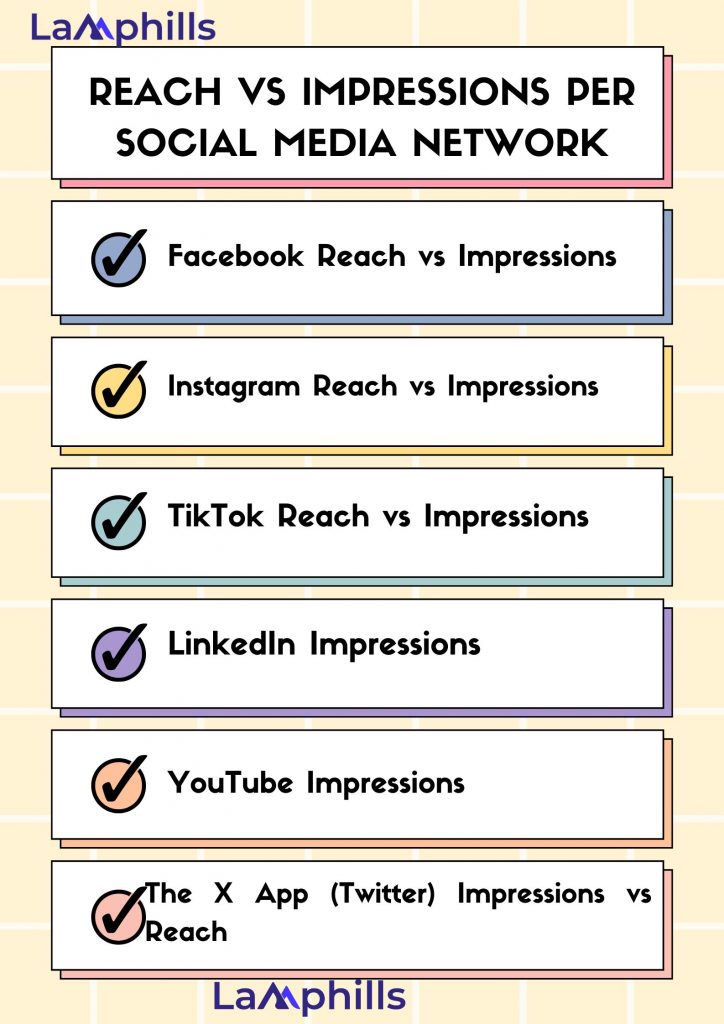Last week, I posted a hilarious meme about cats that I knew would go viral. I mean, who can resist kittens? But a few days later, crickets. My post had barely any likes or comments. Disappointed, I dove into the analytics to see what went wrong. Numbers were flying everywhere—reach, impressions, engagement rate. But two things stuck out: reach and impressions.
See, I thought the more times people saw my post (impressions), the better. But then I realized, what mattered most were unique viewers (reach). So, I started digging to understand the difference between these two metrics, and how they played out on different platforms.
Turns out, there’s a whole world of social media data waiting to be unraveled! So, in this article, based on my research and experiments, I will outline the major differences between reach, impressions, and engagement and everything you need including tips and best practices.
Key Points
- Understanding the difference between reach and impressions helps you gauge how effectively your social media content is spreading and resonating with your target audience.
- If you have a high reach but low conversions (conversions being people who take a desired action, like signing up for a newsletter), it means your message isn’t resonating.
- Viral impressions tell you how many times content linked to your page showed up in someone else’s story.
- TikTok also offers “impressions,” which count every single view of your video, even if the same account has seen it before.
- Reach focuses on the number of unique users who have actually seen your content.
Impressions vs Reach
I’ve been going into the world of social media analytics lately, and two terms keep popping up: reach and impressions. At first, they seemed pretty similar, but after some research, I realized there’s a key difference.
Let’s talk reach first.
What is Reach?
This one’s pretty straightforward. Reach tells you the number of unique users who saw your content. Think of it like the number of people who walked by your social media storefront.
So, if your latest Instagram story has a reach of 3,250, that means that many individual accounts came across it. The same goes for TikTok. If you see a reach of 12,861 for the month, that’s the total number of unique users who saw your TikToks in that timeframe.
What is Impression?
Now, impressions are a different beast. This metric counts the total number of times your content was displayed, no matter who saw it.
Let’s say you put up a cool poster in that social media storefront. Impressions track how many times people saw that poster, even if it was the same person walking by multiple times.
So, if you have a much higher number of impressions compared to reach, it probably means people are revisiting your content. That’s a good sign! It suggests your target audience is digging your stuff and coming back for more.
Understanding the difference between reach and impressions helps you gauge how effectively your social media content is spreading and resonating with your target audience.
Reach tells you how many new people you’re reaching, while impressions show how engaging your content is with the people who see it.
Lamphills Impression vs Reach Template and Checklist
Impressions vs Reach: What’s More Important to Measure
Knowing which is more important can be confusing, so I like to think about it this way: impressions are all about how many times my content is displayed, like how many times my ad shows up on a screen.
This is useful if I’m worried about overwhelming people with my message. If I see a low number of impressions, it might also indicate an issue with my ad itself. It could be that the content isn’t grabbing attention or there’s a technical glitch preventing it from showing.
On the other hand, reach tells me how many unique people actually saw my ad. This is a great way to gauge audience reaction.
If I have a high reach but low conversions (conversions being people who take a desired action, like signing up for a newsletter), it means my message isn’t resonating.
Impression and reach aren’t rivals, they’re teammates! Tracking both metrics gives me a well-rounded picture of how my content is performing. Impressions tell me if my ad is even being seen, while reach reveals if it’s sparking interest.
By working with both, I can tweak my content and presentation to capture attention and ultimately achieve my marketing goals.

Reach vs Impressions Per Social Media Network
As someone who spends a lot of time trying to grow my social media presence, I’ve gotten really interested in understanding how these platforms actually measure how many people see my contents.
You might think it would be straightforward, but it turns out each platform works a little differently! For example, both Facebook and Instagram track your reach and impressions, but they don’t always mean the exact same thing.
So, I figured it would be helpful to break down how these metrics work on each platform.
Facebook Reach vs Impressions
Facebook breaks down reach into three categories, all focusing on unique people who saw your content.
- Organic reach tells you how many folks saw your unpaid posts
- Paid reach focuses on the number of unique viewers who see your Facebook Ads.
- Viral reach tracks how many unique people saw your content mentioned in a story – think likes, comments, or shares – by someone else.
Now, impressions on Facebook are a different species. They measure the total number of times your content was displayed, regardless of who saw it multiple times. Just like reach, Facebook separates impressions into three categories.
- Organic impressions are tracked every time your unpaid content appears in someone’s feed or on your page.
- Paid impressions focus on how many times your ads were displayed
- Viral impressions tell you how often content linked to your page appeared in someone else’s story.
Instagram Reach vs Impressions
On Instagram, “accounts reached” is my go-to for reach. This metric tells me exactly how many unique accounts saw my posts, Stories, or Reels at least once. Think of it as the number of individual eyeballs that landed on my content.
However, for a more detailed picture, Instagram offers “impressions.” This metric counts the total number of times my content was displayed, regardless of whether it was a single person seeing my post multiple times or multiple people seeing it once.
Imagine showing my friend a photo – that’s one impression. Showing it to ten friends is ten impressions, even if some of those friends are the same.
The beauty of Instagram analytics is that you can dig deeper. By using native tools or social media management platforms like Sprout Social, I can see the demographics of my “accounts reached” – everything from top cities and countries to age range and gender. This allows me to tailor my content to resonate with my specific audience.
TikTok Reach vs Impressions
On the ever-popular TikTok, reach simply means the total number of unique accounts that watched my video, at least for a moment. This is a good starting point for understanding how many people my content is reaching.
Notwithstanding, TikTok also offers “impressions,” which count every single view of my video, even if the same account has seen it before.
So, if my friend watches my dance video five times, that’s five impressions. Keep in mind that TikTok’s reach metric is considered an “estimated metric,” meaning it might not be a perfect science.
LinkedIn Impressions
Unlike other platforms, LinkedIn doesn’t have a dedicated “reach” metric. However, I can see how many accounts viewed my profile in the past month. This gives me a general idea of my visibility.
LinkedIn shines with its “impressions” metric. This counts the number of times my post, video, article, or update appeared in a user’s feed. The key here is that users don’t have to engage with my content for it to count as an impression.
But here’s the good news: LinkedIn‘s algorithm prioritizes content that sparks interaction. So, the more likes, comments, reposts, and shares my content gets, the more impressions it’s likely to receive. In simpler terms, high-engagement content gets seen by more people.
YouTube Impressions
On YouTube, things get a bit more nuanced. You won’t find a single, straightforward “reach” metric. Instead, the YouTube Studio offers the “Reach” tab, which provides insights into various traffic sources like suggested videos, external links, playlists, and more. This helps me understand how people are discovering my content.
However, YouTube does have “impressions.” This metric counts the number of times at least 50% of my video thumbnail was displayed on screen for at least one second. Think of it as the number of times my video thumbnail caught someone’s eye.
But impressions alone don’t tell the whole story. YouTube also offers “impression click-through-rate,” which reveals how often viewers actually clicked on my thumbnail and watched my video. This helps me gauge the effectiveness of my thumbnails in capturing viewers’ attention.
The X App (Twitter) Impressions vs Reach
The X app doesn’t currently offer a “reach” metric. However, they do track “impressions,” which simply means the number of times a user sees my X Post in their feed or search results.
While this gives me a sense of how many times my content is displayed, it doesn’t tell me how many unique people are seeing it. Here’s where social media management tools like Sprout Social come in handy.
These platforms can provide additional insights beyond native analytics, helping me track engagement, follower growth, and a wider range of metrics to understand my overall X app performance.
Impressions vs Reach vs Engagement
Deciphering marketing data can feel like cracking a code sometimes. Especially when you’re staring down three terms that seem interchangeable: impressions, reach, and engagement.
But fear not, fellow marketer! I’m here to share what I’ve learned about the key differences between these three crucial metrics and why they all matter.
Impressions
Think of this: you launch a Facebook ad campaign, and it pops up on people’s screens 500 times. That’s 500 impressions – not bad, right? Well, hold on a second.
Impressions simply measure the total number of times your content is displayed, regardless of whether anyone actually sees or interacts with it. Think of it as the raw number of eyeballs your content might have brushed past.
The catch? Impressions don’t tell the whole story. Platforms like Facebook might count an impression even if your ad just flickers on someone’s screen before they scroll right by.
Not exactly an engaged audience, is it? So, while impressions give a general sense of your content’s visibility, they don’t necessarily translate to meaningful impact.
Reach
Here’s where things get a bit more specific. Reach focuses on the number of unique users who have actually seen your content.
Going back to our Facebook ad example, if those 500 impressions translate to 300 individual users, your reach would be 300. This paints a clearer picture of how many people your content is getting in front of, even if it doesn’t tell you how they’re reacting to it.
Engagement
Now we’re talking! Engagement is the gold standard when it comes to measuring how your content resonates with your audience. It’s all about the actions users take – likes, comments, shares, clicks, the whole shebang.
Also, engagement tells you if your content sparks interest and prompts people to interact. This is why engagement reigns supreme over impressions and reach. A user seeing your content is nice, but their interaction truly signifies its value.
Engagement allows me to A/B test different elements – calls to action, visuals, etc. – and see what drives the most response. Understanding what resonates allows me to refine my content to get the most bang for my buck.
Is Instagram Reach the Same as Impressions?
Let me break it down for you. Impressions are all about quantity; it’s a tally of how often your content has been seen.
So, if someone scrolls past your post five times, that counts as five impressions. Reach, on the other hand, focuses on quality. It tells you the number of unique accounts your content has landed in front of.
Let’s say you posted a hilarious cat video. One person might see it scrolling by five times, bumping up your impressions. But that’s still just one person reached, according to your reach metric.
Are Impressions Better Than Engagement?
Impressions are great for gauging how many eyeballs landed on your content, but that doesn’t tell the whole story.
Engagement is where things get interesting. The high fives, comments, and clicks show people are stopping to pay attention.
Sure, tons of impressions might seem like a win, but if crickets are chirping in the response department, it’s time to rework your strategy.
Engagement is the real key to unlocking valuable insights about what’s resonating and what’s falling flat. It helps me squeeze the most juice out of my marketing budget by showing me what actually converts into clicks and actions.
Related Articles
- WHAT ARE IMPRESSIONS ON TWITTER? The Ultimate Guide
- How To Take Off Professional Account on Instagram: Step By Step Guide
- How To Delete Facebook Page: Step By Step Guide






